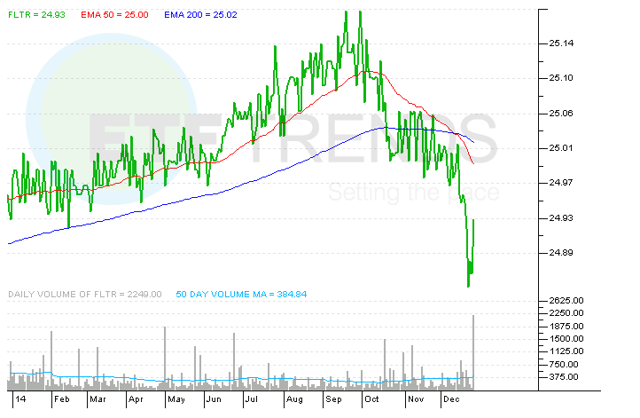Scalper1 News
 Summary Interest rates have declined this year. Fixed-income investors who want to hedge against rising rates can take a look at floating-rate bond ETFs. Floating-rate bond ETF options and how they work. As was the case at this time a year ago, plenty of investors are banking on the new year bring an interest rate hike from the Federal Reserve. Should expectations of higher interest rates gain momentum, it would not be surprising to see investors embrace floating rate exchange traded funds as additions to fixed income portfolios. ETFs such as the iShares Floating Rate Bond ETF (NYSEArca: FLOT ) , SPDR Barclays Investment Grade Floating Rate (NYSEArca: FLRN ) and the Market Vectors Investment Grade Floating Rate (NYSEArca: FLTR ) have floating interest rates . Specifically, floating rate notes have a so-called reset period with interest rates tied to a benchmark, such as the Fed funds, LIBOR, prime rate or U.S. Treasury bill rate. Carolyn Bigda reports for Kiplinger , FLOT owns variable-rate, investment-grade bonds that banks issue to companies; the interest rates adjust every quarter. Unlike most “bank loan” funds, though, Floating Rate holds only bonds that have been extended to high-quality companies, so it has less credit risk than a typical bank-loan fund does. Floating Rate Bond yields just 0.4%. But if the Federal Reserve begins to raise short-term interest rates in 2015, as seems likely, you’ll get the full benefit of fatter yields with little risk to your principal. The fund, which launched in 2011, returned a minuscule 0.3% over the past year and 1.8% annualized over the past three. FLOT, the largest of the floating rate ETFs, has seen increased demand this year as investors have prepared for an interest rate increase that has yet to arrive. The ETF, which debuted in June 2011, has hauled in $355.6 million of its $3.9 billion in assets under management since the start of the year. Still, competition in the floating rate ETF space is intense. In November, Van Eck lowered the fees on FLTR to 0.14% per year from 0.19%. FLTR tracks the Market Vectors US Investment Grade Floating Rate Index (MVFLTR), which consists of U.S. dollar-denominated floating rate notes issued by corporate issuers and rated investment grade by at least one of the three rating services: Moody’s, S&P or Fitch, according to Market Vectors . FLOT charges 0.2% per year and has a 30-day SEC yield of 0.4%. FLTR’s 30-day SEC yield is 0.59%. Market Vectors Investment Grade Floating Rate (click to enlarge) ETF Trends editorial team contributed to this post. Scalper1 News
Summary Interest rates have declined this year. Fixed-income investors who want to hedge against rising rates can take a look at floating-rate bond ETFs. Floating-rate bond ETF options and how they work. As was the case at this time a year ago, plenty of investors are banking on the new year bring an interest rate hike from the Federal Reserve. Should expectations of higher interest rates gain momentum, it would not be surprising to see investors embrace floating rate exchange traded funds as additions to fixed income portfolios. ETFs such as the iShares Floating Rate Bond ETF (NYSEArca: FLOT ) , SPDR Barclays Investment Grade Floating Rate (NYSEArca: FLRN ) and the Market Vectors Investment Grade Floating Rate (NYSEArca: FLTR ) have floating interest rates . Specifically, floating rate notes have a so-called reset period with interest rates tied to a benchmark, such as the Fed funds, LIBOR, prime rate or U.S. Treasury bill rate. Carolyn Bigda reports for Kiplinger , FLOT owns variable-rate, investment-grade bonds that banks issue to companies; the interest rates adjust every quarter. Unlike most “bank loan” funds, though, Floating Rate holds only bonds that have been extended to high-quality companies, so it has less credit risk than a typical bank-loan fund does. Floating Rate Bond yields just 0.4%. But if the Federal Reserve begins to raise short-term interest rates in 2015, as seems likely, you’ll get the full benefit of fatter yields with little risk to your principal. The fund, which launched in 2011, returned a minuscule 0.3% over the past year and 1.8% annualized over the past three. FLOT, the largest of the floating rate ETFs, has seen increased demand this year as investors have prepared for an interest rate increase that has yet to arrive. The ETF, which debuted in June 2011, has hauled in $355.6 million of its $3.9 billion in assets under management since the start of the year. Still, competition in the floating rate ETF space is intense. In November, Van Eck lowered the fees on FLTR to 0.14% per year from 0.19%. FLTR tracks the Market Vectors US Investment Grade Floating Rate Index (MVFLTR), which consists of U.S. dollar-denominated floating rate notes issued by corporate issuers and rated investment grade by at least one of the three rating services: Moody’s, S&P or Fitch, according to Market Vectors . FLOT charges 0.2% per year and has a 30-day SEC yield of 0.4%. FLTR’s 30-day SEC yield is 0.59%. Market Vectors Investment Grade Floating Rate (click to enlarge) ETF Trends editorial team contributed to this post. Scalper1 News
Scalper1 News